 |
|
Page 1 | Page 2 | Page 3
Becoming a Potter
Krishnamurti settled in Ojai, yet often went to Holland to speak to members of the Theosophical Society, who dutifully followed. While on one of these trips, Beatrice Wood purchased a set of baroque dessert plates with a stunning luster glaze. Unable to find a matching teapot, she decided that she could simply make one and in 1933 enrolled in a ceramic course at Hollywood High School. She soon learned that making such a teapot was not so easy and that she was "not a born craftsman." She was, however, determined and attempted the study of glaze chemistry while learning to throw pots through trial and error.
A few years later, she rented a small artisan shop at Crossroads of the World on Sunset Boulevard, where she demonstrated her craft and sold her work.
“I never meant to become a potter,” Beatrice later offered. “It happened very accidentally… I could sell pottery because when I ran away from home I was without any money. And so I became a potter.”
|

Beatrice Wood's Hands |
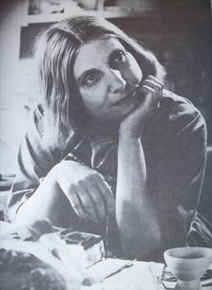
Beatrice Wood in her North
Hollywood
Studio
1943 |
Beatrice Masters Her Craft
In the late 1930s, Beatrice Wood studied ceramics with Glen Lukens, a leading artist and teacher. The two got along well, although Lukens was not one to inspire individuality in his students. She learned a great deal from Lukens, however, and he served to prepare her for her most important mentors - Gertrud and Otto Natzler. Acclaimed for their refined sensibility and technical knowledge, the Natzlers took her on as a student, sharing their techniques and glaze secrets.
"Gertrud Natzler very patiently - I'm not a natural craftsman - taught me to throw on the wheel," Beatrice later recalled. "And Otto Natzler tried to teach me chemistry but he couldn't. I haven't that kind of mind. But they showed me an approach that has been invaluable."
|
Although Beatrice Wood treasured the experience, the relationship became difficult when her career began to take off. Feeling that she was using their glazes and forms, they demanded that she leave, leading to a rift that was never mended and which Wood was saddened by for the rest of her life. Although she noted, "they were my teachers - of course my work is similar to theirs", her work ultimately proved considerably different from that of the Natzlers.
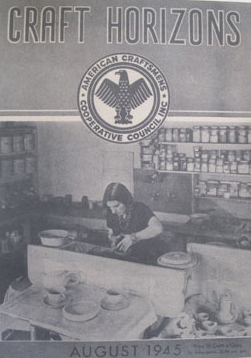
Beatrice Wood on the Cover
of Craft Horizons Magazine
August 1945 |
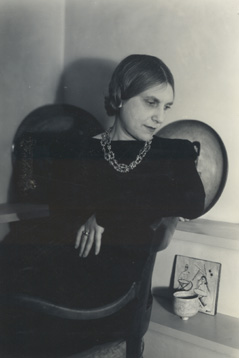
Beatrice Wood at America House
Exhibition
New York, 1947 |
While they sought control over their works through mastery of technique, hers were loose and unconventional by comparison, freely exploring form, glaze combinations and happenstance - exhibiting an embrace of artistic naiveté and the unexpected results of the kiln. |
Ojai
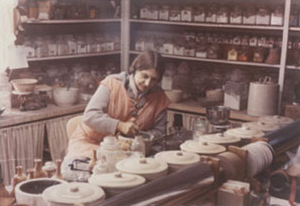
Beatrice Wood in her Studio, McAndrew Rd.
Ojai, CA, 1947 |
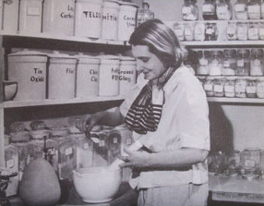
Beatrice Wood in her Studio
1950 |
In 1947, Beatrice Wood felt that her career was established enough that she might build a home in Ojai. Her work had been included in exhibitions at the Los Angeles County Museum of Art and the Metropolitan Museum of Art in New York and she was receiving orders from major department stores including Neiman Marcus, Gumps and Marshall Fields.
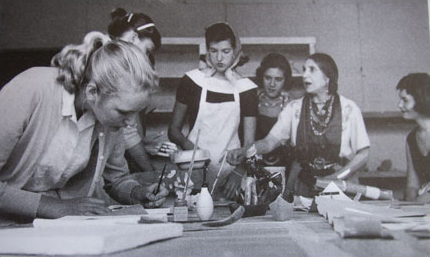
Beatrice Wood Teaching Students at the Happy Valley School
1960 |
Her new home in Ojai was located across the street from Krishnamurti and she fell in easily with the artists, actors and others in search of alternative lifestyles that passed through or settled in the area. She began a lifelong friendship with Vivika and Otto Heino, who helped her to develop her throwing skills and shared techniques for working with luster glazes. Wood became established in Ojai, teaching ceramics for the Happy Valley School (now called the Besant Hill School) and operating her studio and showroom.
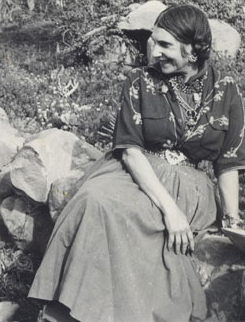
Beatrice Wood in Ojai
1956 |
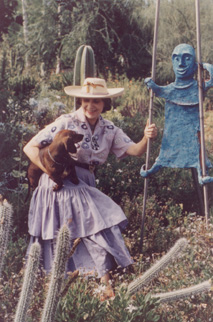
Beatrice Wood in Ojai
1960 |
Beato and Philosophy
When Beatrice Wood moved to Ojai, her house was located across the street from Krishnamurti. This was no coincidence, as she'd read his books and traveled to Europe to hear him speak. Throughout her life Beatrice Wood embraced a life that combined the wisdom of the East, positive thinking, a strong work ethic, a Dadaist sense of humor and a romantic view of life. Her personal philosophy served her well, as she continued working in her studio to the age of 104.
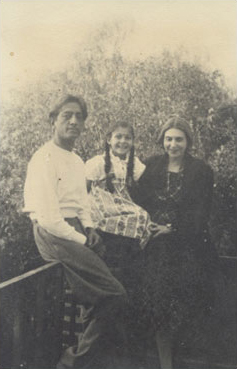
Krishnamurti, Radha Rajagopal,
and Beatrice Wood
|
|
Happy Valley
In 1974, Beatrice Wood was invited by her friend Rosalind Rajagopal to build a home and studio on the grounds of the Happy Valley Foundation. Beatrice sold her home to Vivika and Otto Heino and moved to her new home, the building of which was partly financed by the sale of a Duchamp drawing. Wood lived on the 450-acre parcel of land in the beautiful upper Ojai Valley with the understanding that the home would be gifted to the Happy Valley Foundation upon her death. She ultimately gave them much more; including a generous gift of her own work, her library and her massive collection of folk art. Since her passing in 1998, the Foundation has made her studio available to visitors, who marvel over her work, collection and home and experience the lingering presence of this legendary artist. |
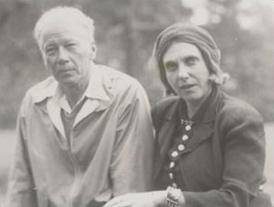
Robert Logan and Beatrice Wood
Happy Valley, 1940 |
| Figures & Narratives
Beatrice Wood became a ceramicist of note with her bowl and vessel forms, yet with her sculptural work contributed a considerably different body of work to the field of contemporary art. At the same time, these works, which she called her "sophisticated primitives", distanced her from the craft and art fields as much as won them over. While the vessels moved along the accepted language of craft, design and the decorative arts, her figurative work embraced an intentionally naïve sensibility. In retrospect, these works round out her oeuvre and connect with her expansive embrace of modes of self-expression, from folk art to Dadaism, yet they prefigured the larger acceptance of the figurative and narrative by artists working in ceramics by decades.

Decoy | Seven Figures Standing on Slab Base | 1948 |
"Now, in pottery I make figures," Beatrice once said of the work. "And a lot of people think they're perfectly horrible. Maybe they are. I've no idea. .But I purposely keep these figures unschooled. Now, I've been told that my pottery is elegant... tradition and all that. But these figures are something entirely different. And I think that's the impact of Marcel in a certain direction that I don't want to keep them schooled."
|
Page 1 | Page 2 | Page 3 |
|
|